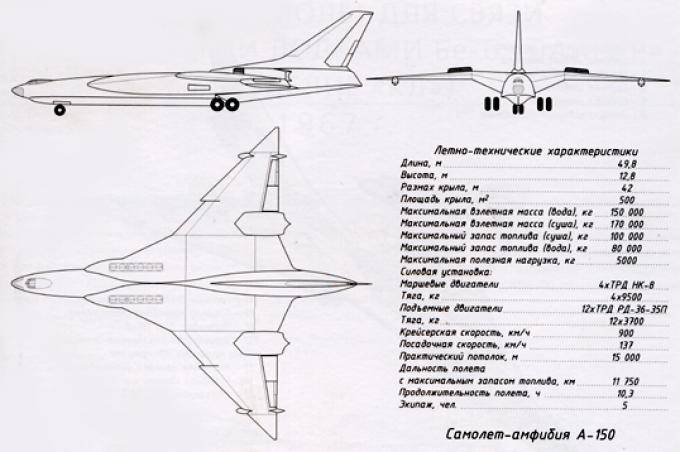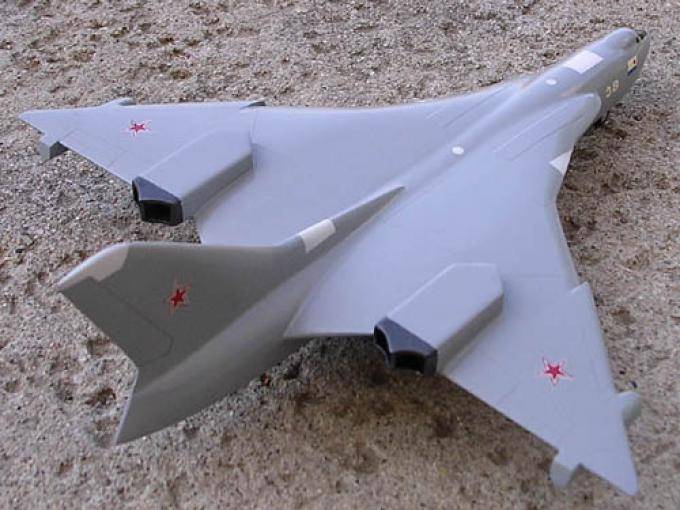The project of multi-purpose amphibious aircraft "Beriev A-150"
For more than 80-year-old history This company gave the country a huge number of amphibians for various purposes. The flying boats released here were actively used by Soviet sailors during the Great Patriotic War and contributed to the victory over fascism. In the postwar years, the company continued to engage in the design and manufacture of amphibious aircraft. The technical and scientific experience accumulated by the engineers of the enterprise made it possible to expand the production of aircraft with a unique combination of high flight-technical and seaworthy characteristics.
In 1970-e years, the scope of activity of this enterprise was significantly expanded. In 70 and 80 of the last century, fundamentally new weapons systems were created here: the A-50 long-range radar detection and guidance aircraft based on the Il-76M military transport aircraft and the Tu-142MR ultra-long-range aircraft based on the Tu-X long-range anti-submarine aircraft. -142. Today, one of the business cards of the enterprise is the multipurpose amphibious aircraft Be-200 "Altair". According to a number of its parameters, this aircraft has no analogues in the world, the aircraft is in demand on the international market, in particular, contracts have been signed for the supply of these aircraft to Indonesia and China.

The number of projects that were implemented in the walls of the TANTK them. GM Beriev and brought to the stage of mass production for all the years of the enterprise, is estimated in dozens, but even more projects remained forever on paper or in the form of layouts. Among them were truly unique to their time development. The A-150 amphibious aircraft is one of the unrealized projects of the enterprise. This mastodon aircraft with a maximum take-off weight of up to 150 tons (when taking off from the water surface) was developed at the enterprise in the middle of the 60-s of the XX century.
It is believed that the development of this project by the Soviet designers pushed the development of their nuclear forces by the Americans. In particular, the adoption of a new two-stage solid-fuel ballistic missile UGM-1960 "Polaris" ("Polar Star") in 27, which was designed to be placed on nuclear submarines. The carrier of these missiles became nuclear submarines of the type “George Washington”. Each such submarine carried the Polaris A16 1 SLBM on board. The first version of the missile could deliver a 600 kt warhead to a range of 2200 km. But already in 1964, the version of the Polaris A3 rocket with a split warhead (3 200 warheads kt) and a range of 4600 km was adopted.
American submarines, armed with new ballistic missiles, went into the ocean and began to patrol. Considering the fact that the USSR Ocean Navy had rather modest capabilities, it was necessary to find a means of countering these boats and the missiles in their armament. Submarines of the type “George Washington” with ballistic missiles Polaris A1 (and then A3) on board could hit objects in the territory of the Soviet Union, being in remote areas of the world’s ocean far from the coast of the country, in areas that were poorly controlled by the Soviet Navy. Understanding this, the Soviet military made every effort to find a solution that would help to effectively deal with US strategic submarines.
Work on creating an impressive jet ocean flying boat with a deltoid wing was started at the Beriev Design Bureau in 1965. By that time, the company already had a wealth of experience in creating the most diverse amphibious aircraft, including the Be-10 jet seaplane, which was mass-produced. From 1958 to 1961, 27 of such amphibious aircraft was launched in Taganrog. It is worth noting that this aircraft immediately set 12 world records, including the speed record for seaplanes - 912 km / h, which has not been broken so far. Unfortunately, today in the public domain you can find very little information about the design of the amphibian A-150.
The new project, which received the designation A-150, was to become a full-fledged multipurpose jet seaplane. The main objective of this flying boat was to be the search and destruction of US strategic submarines. In addition to the anti-submarine function, the aircraft could be used for reconnaissance purposes, as well as during search and rescue operations. It was also planned that the aircraft could be used to combat enemy surface ships and as a tanker aircraft (flying tanker). In order for the transition from solving one task to another to be as simple and fast as possible, two quick-release containers with a different set of weapons and equipment should be installed in two sections located in the center section of an amphibious aircraft.
It is known that the A-150 amphibian had to take off and land both from ground airfields and from the water surface. It was planned that he will be able to act in the Arctic, including from ice runways. Just like the other seaplane Be-26, it had to have a short take-off and landing. To do this, on the A-150 aircraft, it was planned to immediately install 12 lifting engines, which were to be located in a row on 6 engines in the extended leading edge of the wing in front of the aircraft’s center of gravity. In addition to the lift engines, the amphibious propulsion system was to include the 4 turbojet NK-8 engine, which was located above the rear edge of the wing and installed in twin gondolas. The aircraft engines based on the thrust vector deviation in the range from 0 to 65 degrees were provided.

The multi-spar wing of an amphibious aircraft was to be equipped with ailerons and flaps, and auxiliary floats were located on consoles at the wing tips. The landing gear was designed tricycle with a nose strut. The number of wheels had to correspond to the model of the Be-26: two on the nose of the chassis and 4 on the main racks. The front landing gear was retracted into the hull of the seaplane under the flight deck, and the main landing gear into the wing center section.
The crew of the amphibian A-150 was to consist of 5 people: two pilots, a navigator, radar and sonar operators. All crew members were located in a sealed cabin. The total fuel supply (up to 100 tons during takeoff from the earth's surface) was to be located in the wing of the aircraft. The on-board equipment included the following systems: “Flight” long-range navigation system; control system anti-submarine weapons "Zubr"; target display system "Success". The plane was planned to equip defensive armament. Automatic rapid-fire guns were planned to be installed in the bow and stern towers. In addition to the multi-purpose option, more honed under the solution of combat missions, in the Beriev Design Bureau they also worked on the creation of a transport assault flying boat A-150TD.
Flight technical characteristics of the A-150 (draft):
Overall dimensions: length - 49,8 m, height - 12,8 m, wing span - 42 m, wing area - 500 m2.
Maximum take-off weight: 170 t (from land), 150 t (from water).
Maximum fuel capacity: 100 t (from land), 80 t (from water).
Maximum payload - 5000 kg.
Power point:
Marching engines - 4 TRD NK-8, thrust - 4x9500 kgf.
Lifting engines - 12 TRD RD-36-35P, thrust 12x3700 kgf.
Cruising flight speed - 900 km / h.
Landing speed - 157 km / h.
Flight range (maximum fuel capacity) - 11 750 km.
Practical ceiling - 15 000 m.
Crew - 5 man.
Information sources:
http://alternathistory.com/proekt-mnogotselevoi-letayushchei-lodki-amfibii-beriev-150-sssr
http://www.tailsthroughtime.com/2010/08/beriev-150.html
http://www.beriev.com/rus
Open source materials

Information